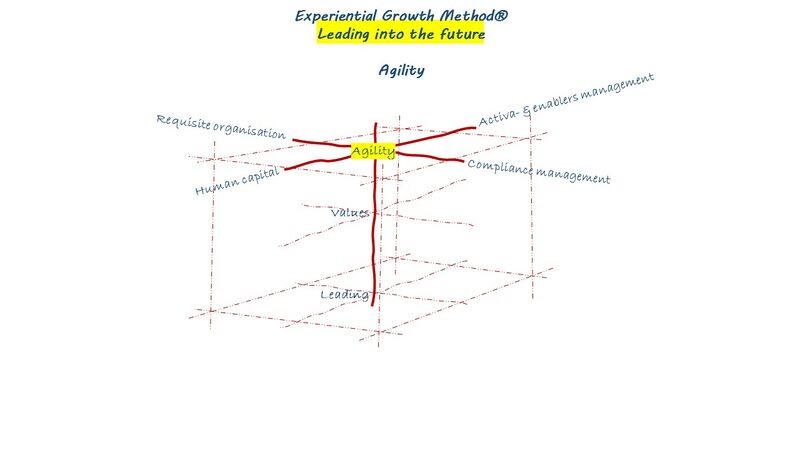Agility
Chapter 3 - Experiential Growth Method® - Deeper dive - Action field
Back to Action fields or Book content
.
Welcome to the Agility page
.
Why agile works
Software/product/service development has a long history of expensive failure. Many have sought to bring this problem under control using project management and other techniques with limited success. What has often proven most effective are approaches that consider the nature of the environment within which the product is created. It begins with understanding the notion of sensemaking:
Sensemaking is the ability or attempt to make sense of an ambiguous situation. More precisely, sensemaking creates situational awareness and understanding in situations of high complexity or uncertainty in order to make decisions. It is "a motivated, continuous effort to understand connections (among people, places, and events) to anticipate their trajectories and act effectively. (Snowden, 2008)
Agile can be a better fit when change is inevitable and the solution is emergent.
Agile is a reasonable approach to "Complex Adaptive Systems," which include fast-changing markets and fast-acting development teams
.
Applying the right tool for a given situation
The word agile means being nimble and flexible. The idea is to be highly responsive to customer needs. It is the ability to “turn on a dime for a dime” to be first or second to market with anything, and the cost/waste of changing direction is minimal. Agile is not a project management methodology. Instead, it is a philosophy concerned with collaborating with customers to arrive at a solution when or where the solution is unknowable and change is inevitable. It is a rational response to uncertainty. The idea is to “embrace change” to your competitive advantage instead of resisting it.
Agile is never the goal — results are, along with an inspired, motivated, and happy workforce
When done right, agile enables you to navigate through unforeseen constraints effectively. It guides how to sense and respond to change and deal with uncertainty. With agility, you can adapt quickly to changing conditions, new opportunities, or emerging threats. Moreover, it greatly reduces the cost of change. Any waste you can reduce is free capacity.
Agile is Decidedly Non-Prescriptive
The values and principles guide one. There is no right way or best practice. There is no playbook. There are only tools you can choose from, and patterns of bounded experimentation allow you to discover what works best in your particular situation empirically. In this way, its hallmark is continuous evolution and growth. Extraordinary and unanticipated results become possible. Reality is your best teacher.
Radical Transparency
Everyone can see where things are, how fast they are progressing, and what's in the way at any time. This degree of situational awareness means that status meetings are a thing of the past. You always know where you are, when you can expect results, and what's slowing the team(s) down.
Emergence
In a complex and fluid environment, one cannot predict the results ahead of time. Agile organisations plan to replan and factor in discovery and learning. When everyone learns, a better product emerges, opening up the possibility of extraordinary innovation. Quite often, the customer doesn't know what they want, and you don't know what they want. You discover it together as you partner and iterate on a solution. For many, emergence as a property can be counterintuitive, but it is the reality in highly complex and dynamic environments.
Lean Thinking
Most agile work relies on the Toyota Production System, Lean Thinking, and The Toyota Way. Working with agility takes lean thinking into account. The two go hand in hand.
.
Agile features
Quick Delivery
Very short and complete mini-projects, the shorter the better, each one producing a deliverable of incremental value to the customer or consumer of the deliverable.
Safe Fail
Safe-fail is the opposite of fail-safe. It creates "enabling constraints" to foster experimentation and innovation while containing risk, resulting in a greater degree of innovation.
Autonomy
Self-organising and self-managing teams do not need direct supervision. Distributed leadership gives maximum value when the teams are accountable for the results. In complex environments, one creates "enabling constraints" or guardrails when granting autonomy (for example, a time box). In addition, autonomy is an intrinsic motivator for knowledge workers and increases morale and productivity.
.
| Content source |
|---|
| Michael Wollin |
.
.
Relations of Agility within Leading into the future (and Corporate- & organisational futuring)
.
.
There exists a close vertical relationship within Leading into the future:
- Outer focus: Agility
- Other focus: Value development
- Inner focus: Leading
.
On the Outer focus level, an affiliation exists with Organisational futuring:
- Human capital
- Requisite organisation
- Activa- & enablers management
- Compliance management
.
And Corporate futuring:
- Operational Strategy
- Financial management
- Commercial management
- Business model
.
In concrete terms, this means:
- The trio - 'Leading', 'Value development' and 'Agility' - is inextricably linked.
- Your 'Agility' contributes substantially to 'Human capital', 'Requisite organisation', 'Activa- & enablers' and Compliance management.
- Furthermore, 'Agility' is part of the Outer focus level where 'Organisational-' and 'Corporate futuring' meet.
.
.
Questions we can ask ourselves when contemplating Agility
- Supports our 'Agility' our 'Value development' and our 'Leading'?
- Is our 'Agility' robust enough to generate a viable 'Human capital', 'Requisite organisation', 'Activa- & enablers' and Compliance management?
- Is our Agility a 'collider' or a 'mediator'?
.
